For the past 10 years I have been writing a semi-regular series of article/editorials for the quarterly Oregon Fish & Wildlife Journal. This popular outdoor magazine is now in its 43rd year of publication and has a circulation of about 10,000, including all elected Oregon officials and most rural Oregon barbershops. Founder Cristy Rein still remains firmly in charge as the magazine’s publisher and conservative editor. My writings for her have mostly focused on forest restoration, wildfire history and forestry education and can be found here:
http://nwmapsco.com/ZybachB/Articles/Magazines/Oregon_Fish_&_Wildlife_Journal/
My most recent entry, published in early October, is an article about the risks posed by North Umpqua River basin snags in the aftermath of the 2020 Labor Day Fires. The North Umpqua is in Douglas County, in Oregon’s western Cascades.
This article is the first in a two-part series and details the relative risks posed to people, property and wildlife by leaving snags on the landscape. The next article will suggest mitigating forest restoration strategies for each of the four major landownerships (USFS, BLM, industrial tree farm, rural residential) in dealing with snags created or reburned by these fires. Both articles are directly derived from a commissioned report I wrote last summer for Douglas Timber Operators (DTO) under the direction of Matt Hill, DTO Executive Director.
The topic of North Umpqua snag management became suddenly controversial last week when lawyers for three environmental organizations filed a legal action against plans to remove “too many” snags along Umpqua NF roadways and recreation areas: https://www.nrtoday.com/news/environment/douglas-county-to-intervene-in-hazard-trees-lawsuit/article_4c5dc369-3a29-54e0-a9d4-a2097b473f8c.html
****************
The following pages contain the 10 images, two maps and table from my article, along with their captions. These give an idea as to the scope of the snag problem as it has developed during the past 20 years, and particularly on Umpqua NF lands within the North Umpqua basin. First, some background, starting with the basics:
A snag is a dead, standing tree. When it falls to the ground it becomes a log. Once a snag is created, the question becomes whether to leave it standing, or turn it into a log.
In western Oregon the most common tree is a Douglas fir. It typically grows in vast stands of even-aged trees numbering dozens or hundreds per acre. Contiguous stands and individual trees can grow and survive for centuries, even when surrounding stands have been decimated by windstorms, floods, landslides, insects, spot fires or other means. However, when a “crown fire” goes through a stand of Douglas fir, nearly all (or all) of the trees are killed and instantly become snags.
The September 8-10, 2020 Labor Day Fires in western Oregon burned nearly a million acres of land — mostly Douglas fir forestland — killed 11 people, destroyed more than 4,000 homes, polluted the air with toxic smoke for nearly two weeks and killed millions of native wildlife.
Of this amount, the Archie Creek Fire, along the North Umpqua River, was responsible for one human death, more than 150 people losing their homes, and over 131,000 acres, mostly forested, being burned. Due to its large size and rapid spread, mortality of native plants — including extensive stands of Douglas fir — and animals approached 100% within much of the fire’s perimeter (see Figures 1 and 2).
Beginning in 1987, and accelerating after 2002, the number of large-scale fires has increased dramatically on the North Umpqua, and particularly on the Umpqua NF (see Table). Immediately following the Archie Creek Fire, the USDA Rapid Assessment Team (RAT) noted:
“Over the past 20 years, 28% of the Umpqua [NF] has burned in wildfires, with the total acreage being higher due to several areas being burned two to three times over the past 20 years. Less than 1% of these past fires in total have been salvaged, with the majority of snag loss occurring along roadsides as danger tree mitigation to keep open public access. Therefore, snag abundance at the landscape level will likely be above the 80% tolerance level on the North Umpqua and Diamond Lake Ranger Districts for quite some time.”
The important statement in this quote is that “several areas [have] burned two to three times over the past 20 years.” Following the 2020 RAT report, the 2021 Jack Fire, Chaos Fire and Rough Patch Complex have burned more than 75,000 additional North Umpqua acres on Umpqua NF lands; much of which already had snags from earlier fires.
Summary: Almost all major wildfires on the North Umpqua during the past 20 years have taken place on the Umpqua NF. Almost all of the snags resulting from these fires have been left in place, many burning a second or third time since they were initially created. Snags provide a continuing and documented threat to burn again; to kill and harm people and wildlife; to disrupt travel, power and communications corridors; to accelerate erosion; and — compared to living trees by most people — are ugly and unsightly. Their value as ephemeral wildlife habitat is open to interpretation.
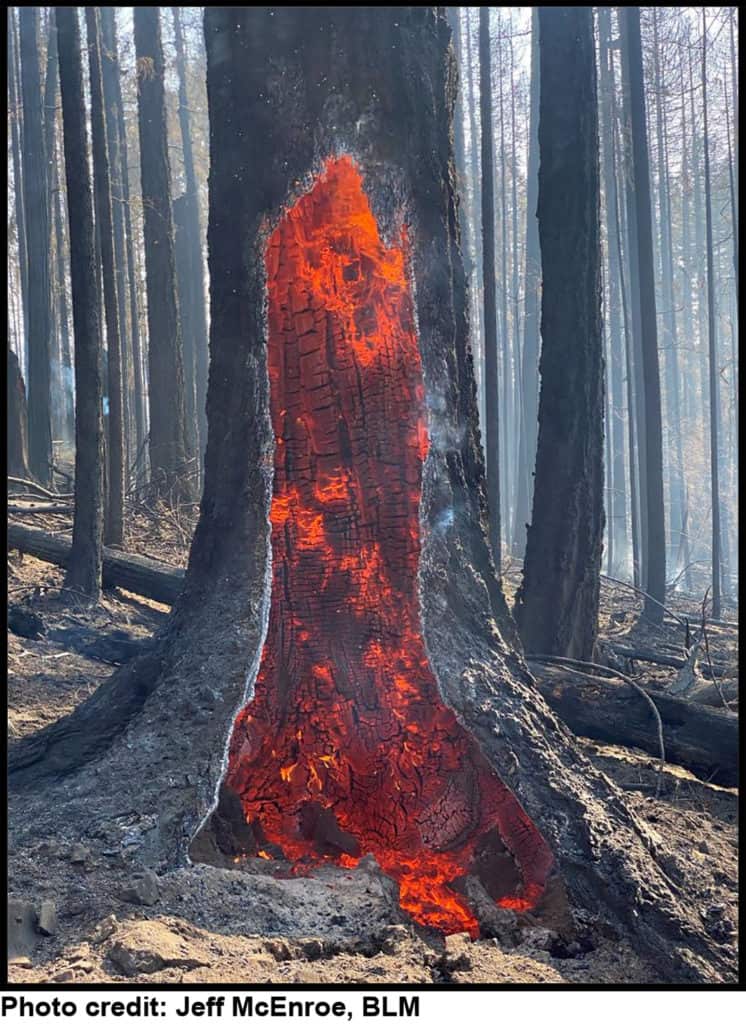
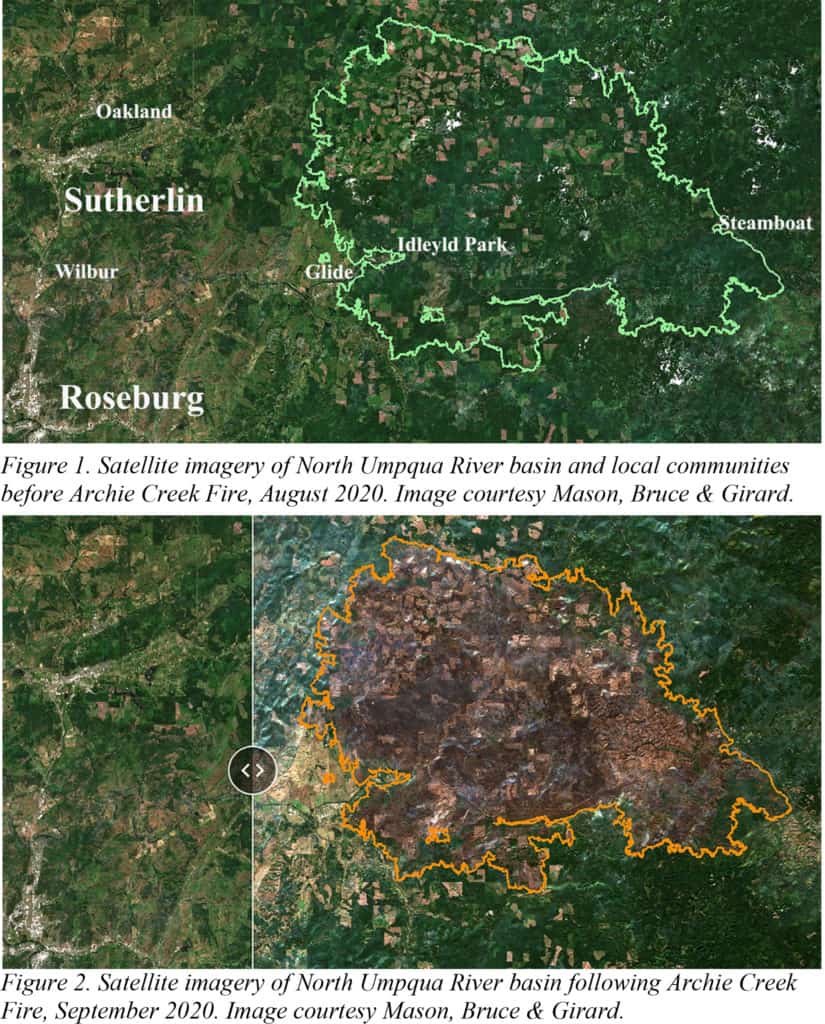
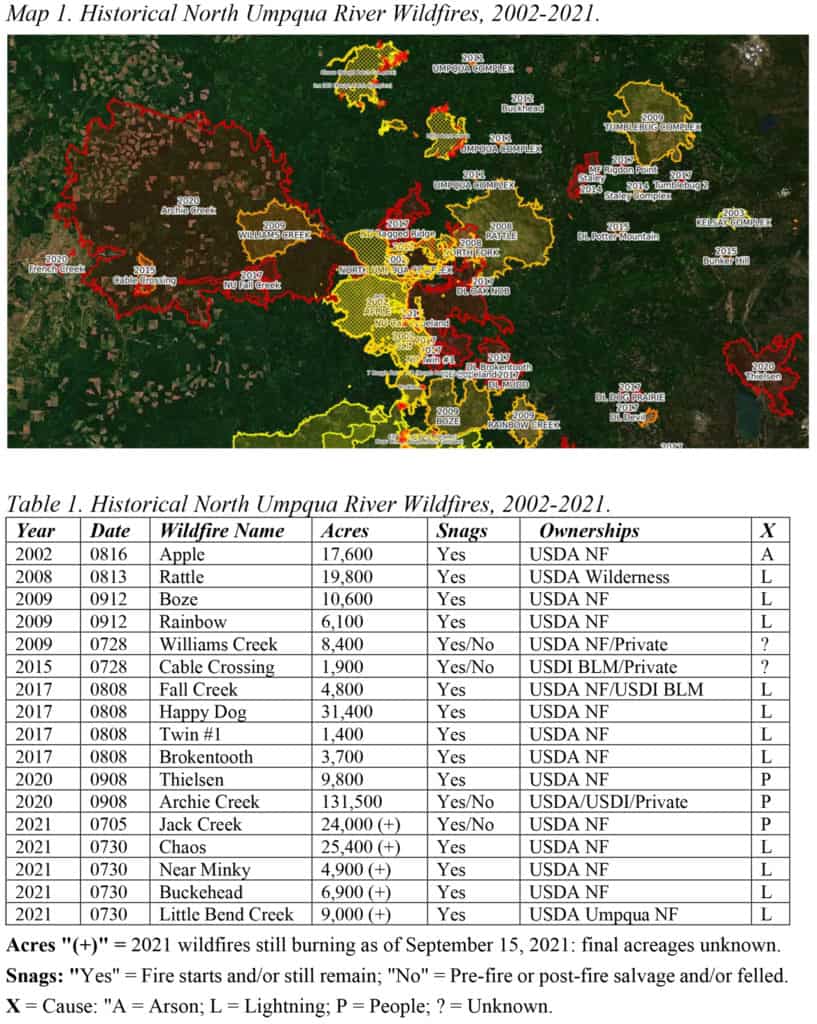
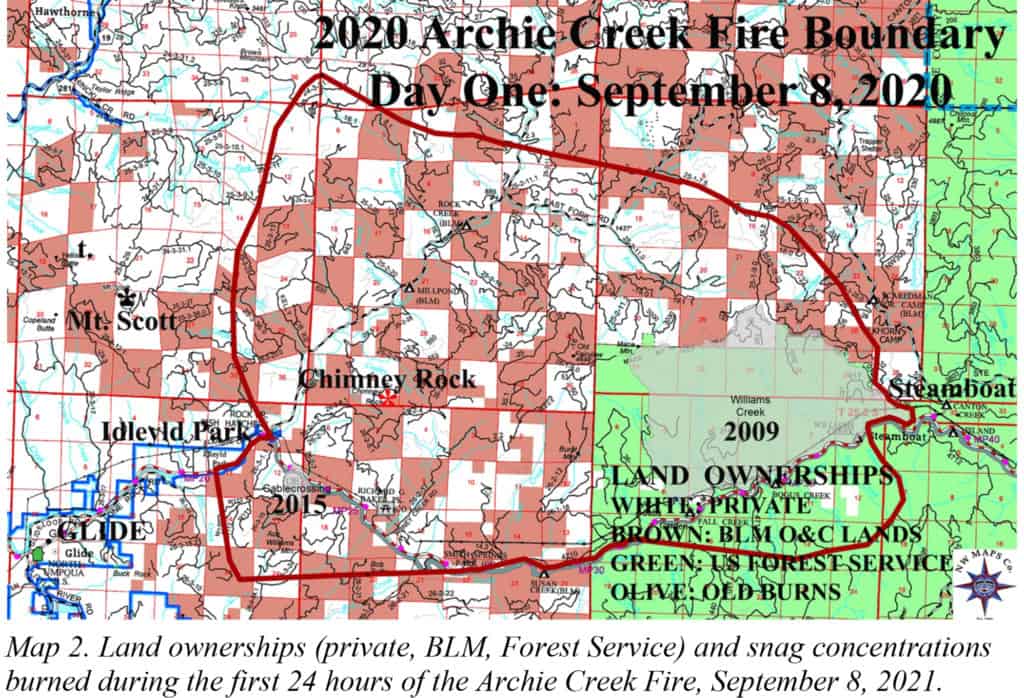
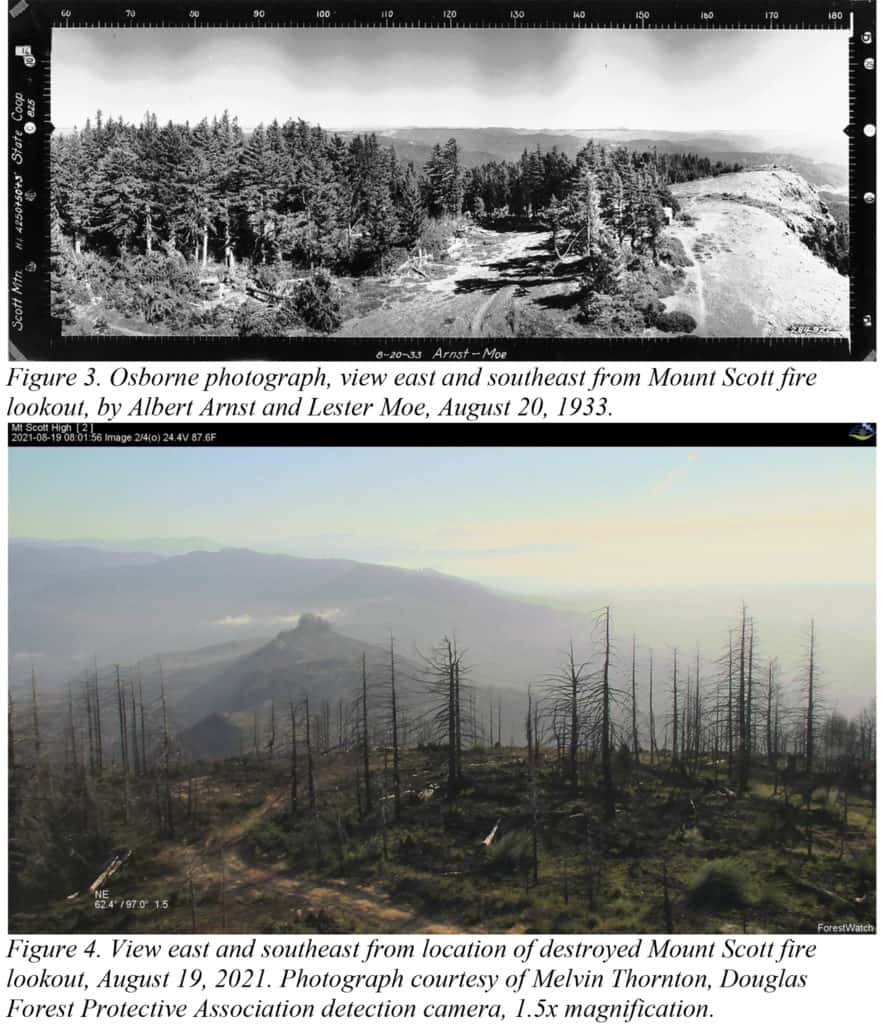
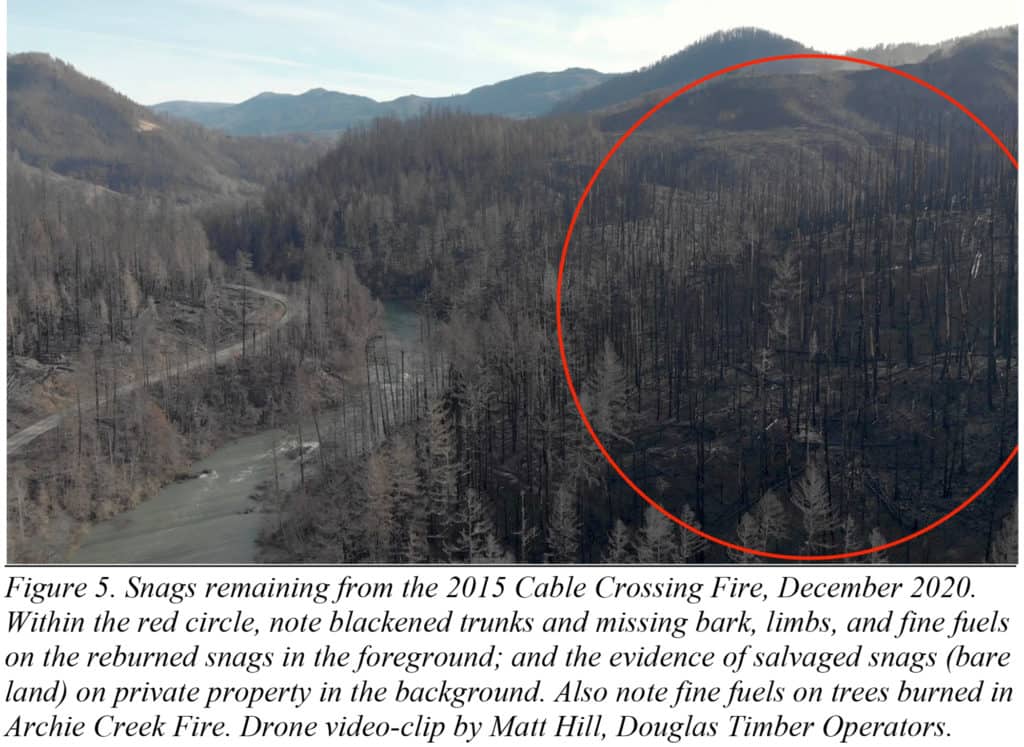
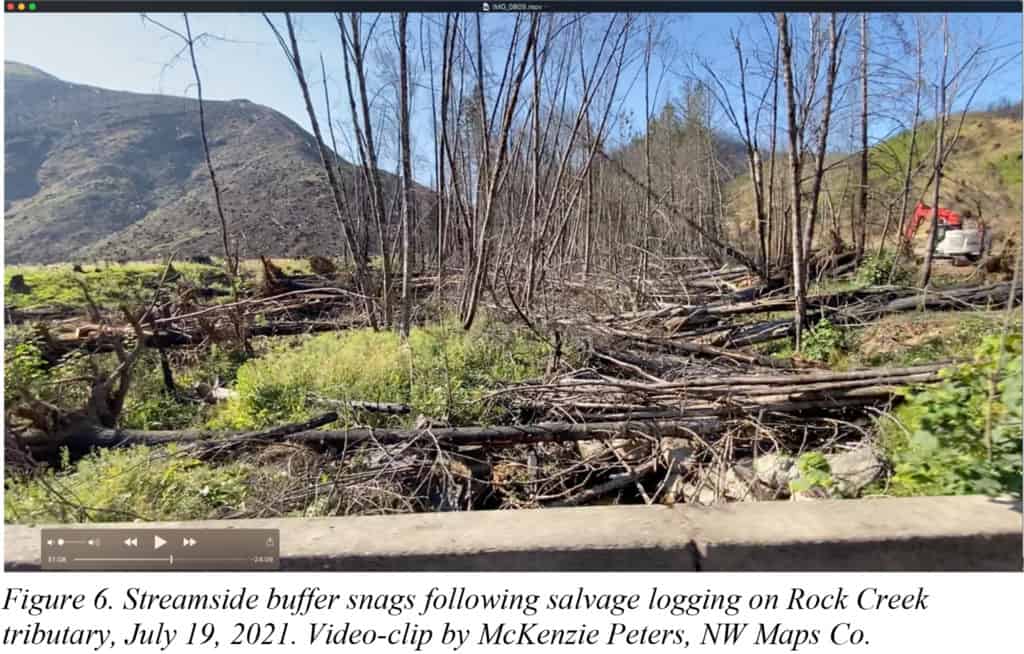
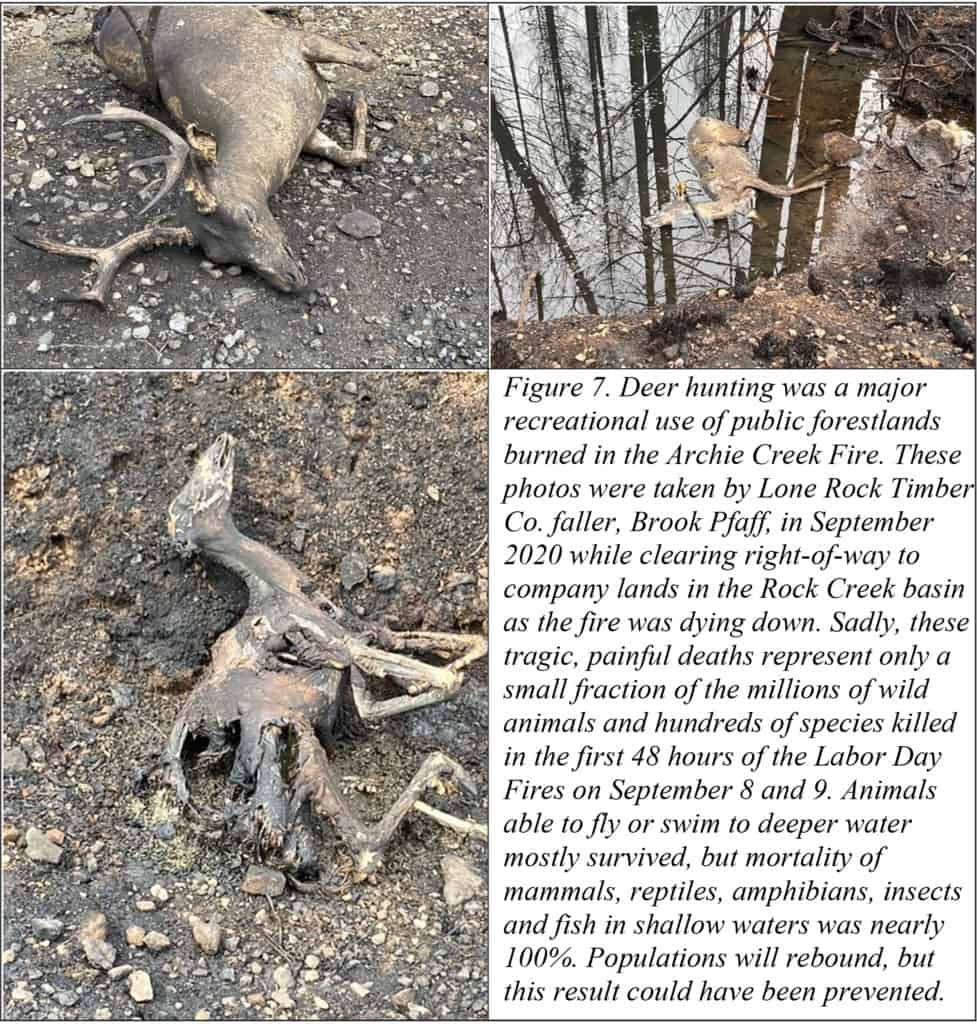
I skimmed enough of your piece to say that I definitely disagree with you!
For one thing, a report commissioned by DTO is likely to be biased given what I know about the group.
While it’s true that some standing dead trees, or snags, can present a hazard not every one is hazardous. As a forester for the USFS in Washington state I used to conduct hazard tree analyzes in developed campgrounds. We annually assessed the trees around campsites for decay and other factors that might make them hazardous to campers. The methodology was developed by plant pathologists and other specialists in the Region 6 RO in Portland.
One key principle in evaluating risk was how long would people be exposed to the hazard? For example, a tree directly over a picnic table or tent site poses more risk than one along the access road into the campground. That’s because people spend more time in the zone where a tree might fall.
Using this principle, the relative risk to hikers on a trail or motorists on a forest road is relatively low because most people are passing by the “hazard tree” and are not exposed for long. A dead tree over a trailhead parking area would be rated differently than one along a road.
My recollection of the literature is that standing dead trees can provide important wildlife habitat so your claim to the contrary makes me wonder about your perspective.
In my professional opinion as a forester, it would be a mistake to undertake large scale removal of standing dead trees along roads or trails on NF land. BTW – The USFS manages, but does not own NF land, the land belongs to the people of the U.S. although we often overlook the Native Americans who lived here before Europeans arrived.
As for wildlife lost during a fire, yes that can happen and has been happening for many years.
I worked for the USFS during the May 18, 1980 eruption of Mount St. Helens and spent that Sunday about 15 miles east of the volcano in an unaffected area. Certainly there were some wild animals killed during the eruption. That too has been happening here in the PNW for almost as long as there’ve been active volcanoes.
Hello Old Woodsman: It sounds like we are in more agreement than disagreement. My Mom was from Cougar Washington and I watched the sun set on Mt. St. Helens on May 17, from Morton the evening before it erupted. I was running a reforestation business at the time and subsequently canceled two pre-commercial thinning projects affected by the blast. I have always been leery of the “critical habitat” claims assigned to snags, and particularly when they are instantly created and affecting tens of thousands of trees. Also, I don’t think they should all be removed — just those threatening people, homes, roadways, recreational areas and powerlines. But I do think they should be sold ASAP on federal lands whenever possible — to the benefit of their owners and to the rural families and communities that live nearby.
Bob, I’m glad you said that.
“Also, I don’t think they should all be removed — just those threatening people, homes, roadways, recreational areas and powerlines. But I do think they should be sold ASAP on federal lands whenever possible — to the benefit of their owners and to the rural families and communities that live nearby.”
Looking back over the last 50 years or so, I think it’s interesting to look at what people were concerned about. (I wasn’t in Oregon most of the time so my memory might be spotty).
Clearcutting.. don’t do them, make them smaller, then Jerry Franklin saying they should be “big and messy” that was about when I moved away.
Then.. the FS does too much cutting (not necessarily clearcutting).. then Spotted Owl came along.
Then .. the FS shouldn’t salvage log.
Now we’re talking about roadside hazard trees and whether it should be one or two tree lengths. If they’re 100 feet then we’re talking about disagreeing about 100 feet of cutting, along roads, which conceivably aren’t prime wildlife habitat and don’t have roadless values.
If you take the long view (in that part of the country) we are disagreeing about smaller and smaller things. We’ve come a long way.
The archaic notion that snags will burn again can be slightly true in drier more interior arid forests, but in the PNW these dead trees are kept wet by high humidity and lots of rain for all but a couple-few months out of the year and because of this they’re quickly colonized by many kinds of fungus, which not only absorb more carbon as they grow, but they absorb and store a great deal of water in both standing and downed logs.
Anyone who’s tried to burn a rotten log on a campfire will tell you it doesn’t burn very well at all. Of course if you’re a timber industry puppet that never learned anything new about natural science since the 1970’s you want to cut down every last snag before the fungus takes over, which causes blue stain and degrades the value of the wood.
The argument for risk of reburning is yet more fire suppression propaganda that never recognises any value in lower fire risk unless it’s done with chainsaws for the sawmills. I can show you one wildfire after the next that burned at a lower intensity soon as it moves into previous burned over areas, which is the basis of fire suppression ending. Of course fire resilient landscapes isn’t the goal, making money off sawlogs in whatever dishonest way possible is the goal.
From a biological science perspective, as well as a from a lack of funding for for future tree farming on federal land perspective, this lawsuit is very much appreciated.
These snags provide long term soil recruitment and are second only to old growth forests in ecological value. Forest have evolved for hundreds of millions of years in direct relationship with fire and snag forests are way less flammable and safe then shrot-rotation tree farms.
Of course, the dim-witted folks who want them all cut down will fail in court because their science and irrational view that only clearcutting and stripping the land down to bedrock is the only way to be safe from fire is a recipe for making massive amount flashy fine fuels like invasive weeds and highly flammable tree farm trees in the next decade or two, which is something that snag forests help to prevent.
This author is biologically illiterate when it comes to long term soil recruitment and the necessity of the habitat dead wood provides, especially when it comes to how far soil and forest regrowth is set back from clearcutting snag forests. As always, I have lots of references but on this website it’s been shown again and again that actual science and facts don’t matter, only nostalgia for the good old days and we’d clearcut everything to solve every problem matters. So grateful this lawsuit will shut these clearcut maniacs down as best it can.
Jeez, Deane: When you don’t know what you are talking about, it’s best to avoid name-calling. To state that the well-known and documented fact that snags will routinely reburn in subsequent fires is an “archaic notion” is okay in a private conversation, but not too bright in a public forum.
To refer to people that want to harvest snags as being “dim-witted folks” or “clearcut maniacs” just demonstrates your bias as well as your lack of knowledge on the topic. To call me a “biological illiterate” is just plain stupid. Plus rude. My PhD in the study of western Oregon wildfires was from 2003, not the “1970s.” I’m curious what your credentials are. I’m guessing not biology or forestry.
She thinks she wins if she can troll us into responding to her ‘tripe typing’. On a blog like this, her comments are not effective in turning conservationists into preservationists. Actually, I have a good feeling that ordinary Americans are becoming enlightened to the scientific truths of forest management. (Despite the rightwing conspiracy theories) We need to keep marginalizing the extremists, from both political extremes.
Dianne I pretty much summed up my view of your intelligence when you said fungus absorbs carbon.
Every single fire salvage project I have ever worked on did not include clearcut units. Today’s modern Forest Service fire salvage projects are more like ‘snag thinning’, with snag retention requirements on all cutting units. Additionally, healthy green trees are not cut in fire salvage projects. We keep seeing all the same tired accusations of clearcuts, without actual evidence to support their ‘conspiracies’.
Also important to note: In some cutting units, entire clumps of snags are left, always away from roads, powerlines, canals, etc. to meet snag requirements (for several reasons).
These roadside hazard tree removals (not the same as a salvage sale of non-hazard trees) have, after the 2020 Labor Day fires in Oregon, definitely been clearcuts – a clearcut that is 1-2 treelengths from the road – in many cases. There was a fair amount of controversy over the Oregon Department of Transportation’s oversight of roadside hazard tree removal along state highways after the 2020 Labor Day fires. Many of these routes are/were “Scenic Byways”.
As for reburns, we’re seeing them more often now. The presence of fuel from previous fires is certainly one factor contributing to that, but drought and extreme weather events also contribute to those reburns as well. I think it comes down to the services that we want forests to provide (particularly water quality for people and fish) and the need to manage landscapes across land ownership/management boundaries to deal with the inevitable fires. I used to think that fussing about post-fire snags was much ado about nothing. After the 2020 and 2021 fire seasons in Oregon, I’ve changed my view. We need to be thinking about post-fire fuels management in these areas and how the natural processes of post-fire fuels accumulations will affect what happens in the future when the next fire ignites. This doesn’t necessarily mean removing every snag, but it means putting more conscious thought into it than we have done in the past.
I have also seen Oregon roadside hazard tree projects where the hazards were merely felled, and left for woodcutters. It looked odd to see these felled and limbed trees right next to the highway. It was not in a burned area, though.
I do agree on the ‘snag thinning’. Re-burns are a stark reality in our dry forests. Here in California, we have a living (and dying) laboratory in Yosemite, where re-burns are in plain view. The Foresta area within the Park has burned three times in the last 30 years.
Hi A.. we have those also in our part of the country along roads due to dead bark beetle trees. You call them clearcuts, I think that’s an interesting word because I have always thought of clearcuts as related to timber harvesting practices. Tree clearing for safety, keeping power lines clear, or even for residential development, I’ve always called “clearing.” Perhaps surprisingly to you, it hasn’t been that controversial around Colorado. It may be because a treelength is a longer distance in Oregon. Another reason could be that our eyes are more comfortable with openings, being in dry country. Or it’s nice for safety to be able to spot animals more easily before they walk or run out onto the road. It would be interesting to map the areas where roadside clearing is controversial and where more or less not.
ODT has a very poor track record with managing roadside trees. They decimated the forest outside of Sisters OR by spraying untested chemicals (https://www.opb.org/news/article/odot-ponderosa-pine-pesticide-logging-sisters-highway-20/). They need to fire whoever is in charge of making these decisions and get some actual foresters on staff.
Global warming has been accelerating since humans began setting fires to clear habitat, as a weapon or just for amusement. Neanderthal mastered fire at least 200,000 years ago. Evidence that we humans have eaten or burned ourselves out of habitats creating catastrophes behind us is strewn throughout the North American continent.
Just because we can manipulate the environment doesn’t mean we should.
Lifted from Paul Horsted’s Facebook page two photos of the Black Hills National Forest were taken 145 years apart but the same fire-charred snags appear in both.
Standing snags are worlds unto themselves; why is it up to us to determine their futures?
What do we do with 200,000,000 dead trees in California, right now? Let em burn? (That is quite the carbon footprint, eh?)
Some parts of the Sierra Nevada experienced 14 wildfires in the last 100 years, according to tree rings. With so many more humans running around in our forests, should we be ‘hoping and praying’ for ‘natural wildfires’, while preserving dead forests? It’s not a good plan.
I’ve logged several burn salvages with skidders: it’s dusty, destructive and deleterious to waterways. Whoever’s crazy enough to go cut snags on foot with a chainsaw has a death wish.
Some of us enlightened folks know that some skidder operators are very good in doing the least damage possible, while getting the job done. Short term temporary impacts are so much more acceptable than longterm ecosystem damages associated with re-burns.
No doubt the tiny number of skidder operators with Master’s degrees dwarfs the quantity of post-docs with time on a skidder.
I remember talking with the Umpqua forest supervisor many years ago and she mention how she was overwhelmed by the beauty of the North Umpqua on her first visit. I wonder what she thinks now as she drives along the burnt out North Umpqua. It just makes me sad when I see much of this once lush green old growth forest reduced to burnt snags.
The Forest Service on the Umpqua was at it again this summer spending millions of dollars burning our forest till the rains came and put the fires out.
I find it incredible that the Oregon Wild, Cascadian Wildlands, and the strangely named Umpqua Watersheds,(not to be confused with Umpqua Watershed Association that works in riparian restoration.) pretend to voice concern about our forests. They can voice concern that removal of less than .05 % of the standing snags on the Umpqua would be detrimental to the forests but burning up tens, or hundreds of thousands acres of old growth every summer is of no importance, and might even be beneficial to the forest. For me they have no credibility.
The proposed actions of the FS would have no adverse affect upon long term health of the forest.
Not removing some of the snags would have a long term affect on ability to access the forest whether it be for recreation or management. Also from my viewpoint not doing anything would just add to the current total lack of respect for our timber resources.
Hmmm, our “current total lack of respect for our timber resources.”
That’s an interesting comment Bob.
I paid for my undergrad forest management degree driving a garbage truck for 3 summers. Talk about an utter lack of respect for forest resources! I dumped lots of virgin fiber paper and cardboard plus dimensional lumber at the opening of an incinerator!
That was many years ago but TBH with the exception of some places, primarily urban areas, we aren’t doing a whole lot better now in terms of making more efficient use of wood products!
Even here in Portland, Oregon where there are great programs I see lots of good quality dimensional lumber going into dumpsters for disposal, or use as hog fuel for boilers, rather than being salvaged for reuse. What a waste!
As a society we still prefer to demolish buildings rather than 1 – build a quality structure that will last for generations or 2 – working with or remodeling the building someone else designed rather than wiping the slate clean to build our “dream” home.
As a forester and environmental advocate I think we have a very LONG WAY to go in terms of showing respect for our natural resources! Sorry, but to me a standing dead or live tree is much more than 2X4’s!
I see watersheds, healthy salmon runs, ecosystem services, carbon storage and so much more! I was schooled as a timber forester but I’m really glad I never drank the Kool Aid!
If you ever feel like it take a dive and look at one of these proposed sales and see what you think. I think we all want healthy watersheds with fish in them.
We ve logged our forests to death over the decades. That is one major factor why they’re burning. And our solution, ludicrously, is to log them some more. We ve done this to ourselves, or, the timber industry has done it to the public. Sad.
Big blanket statement. Proof? Scientific, multi-party proof, that isn’t agenda driven? From reputable journals, from reputable field based sources, beyond one single photo?
Please and thank you.
Hi Dave: I’m not sure why you are saying that “logging forests to death” is a “major factor” as to why they are burning. My research — at least for the Douglas Fir Region of northern California and western Oregon and Washington — shows just the opposite. When our public forests were being heavily roaded and logged during WW II national defense and post-War baby boomer housing needs, we had very few major fires. Wilderness designations and ESA regulations have had the exact opposite effect — ever more and larger wildfires, almost annually. And, side note, “timber industry” and “ourselves” are pretty much one-and-the-same. I’m guessing you live in a wooden house with wooden furniture.
AND, above all, PRESERVE the controversy by blaming the past. Keep those donations coming into anti-forestry groups. Never mind about the details of current land management planning.
Here is a real world example of recent logging in Oregon, on the Fremont-Winema National Forest. Yes, I had a small participation in this project.
https://www.google.com/maps/@42.6282057,-121.7030552,1081m/data=!3m1!1e3?hl=en
“logged to death”??
As a wildlife surveyor, I have been on the ground in the middle of wildfires, and I have seen the before, the during and the after. Maybe your hypothesis is true for Roseburg but it isn’t on the coast. I surveyed the Brookings Bar fire area extensively, and the areas with old growth and snags burned the least. The areas that burned the worst were the ones that were most managed. BLM land left largely unmanaged was just burned in the understory. South Coast Lumber land was sterilized for 3 years after the fires, nothing grew there. The more clearing you do, the less moisture is held in the soil, the worse fires get. It’s pretty obvious when you are in a private stand in July, and you can’t find any moisture in the soil but in the old growth there is moisture just 2 inches down.
I was here, back in 2004. Not much has grown back within this part of the Biscuit Fire. Be sure to zoom out, incrementally, to see the scope of that destruction.
https://www.google.com/maps/@42.4425125,-123.7943729,136m/data=!3m1!1e3?hl=en
Hi Jonathon: I think you are referring to the 2017 Chetco Bar Fire. It partly took place in the 1987 Silver Complex and 2002 Biscuit Fire burns, and was followed by the 2018 Klondike Fire. A progenitor of these events was creation of the 1964 Kalmiopsis Wilderness. Now, much of the forest has been converted to brush.
I’m not sure how extensive your wildlife surveys may have been, but my “hypothesis” is also true for coastal Oregon, where I completed my PhD research on the topic. I will say that what appears to be “pretty obvious” to you, is not supported by actual research. My best guess is that you have actually had relatively limited experience with wildfires and a strong bias for what you believe to be true regarding forest management. Accurate?